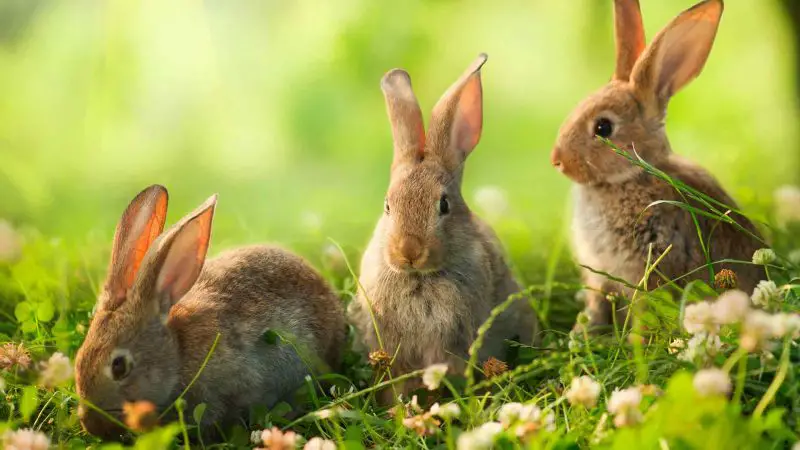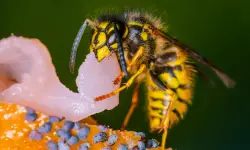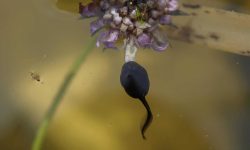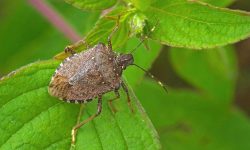Wild rabbits are some of the most recognizable and beloved animals in nature. Found in grasslands, forests, and even suburban backyards, these small herbivores play a vital role in ecosystems as both grazers and prey. Their diets are perfectly adapted to their habitats, ensuring survival through changing seasons.
Unlike domestic rabbits that rely on commercial pellets, wild rabbits must forage constantly for natural foods. Their feeding habits shift with availability — fresh greens in spring, woody plants in winter, and tender shoots during summer. This adaptability makes them resilient and widespread across the world.
Understanding what wild rabbits eat offers a fascinating glimpse into their behavior, nutrition, and ecological importance. From nutrient-rich grasses to sweet fruits, each food helps these animals stay healthy, energetic, and always alert to the dangers of the wild.
Understanding the Wild Rabbit Diet

A Herbivore’s Natural Menu
Wild rabbits are strict herbivores, meaning they eat only plant-based foods. Their digestive systems are built to process fibrous vegetation efficiently. Instead of eating large meals, rabbits graze throughout the day, consuming small portions of various plants. This continuous feeding keeps their gut bacteria balanced and prevents digestive issues.
Their sharp incisors never stop growing, so chewing fibrous food helps wear them down naturally. Everything they eat — from grasses to bark — serves both nutritional and dental purposes, keeping them healthy and strong.
Seasonal Feeding Habits
A wild rabbit’s diet changes with the seasons. In spring and summer, they enjoy lush grasses, herbs, and garden vegetables. During autumn, they switch to bark, twigs, and dry leaves as fresh greens become scarce. In winter, when snow covers the ground, they rely on woody plants and leftover crops.
This adaptability allows them to survive in nearly any environment, from meadows to deserts. Their ability to find nourishment year-round makes them one of nature’s most efficient foragers.
Nutritional Needs
Wild rabbits require a balanced intake of fiber, vitamins, and minerals to stay healthy. Fiber keeps their digestive systems active, while calcium and phosphorus support bone and teeth health. They also need hydration from moisture-rich plants, as they drink very little standing water.
Their natural diet ensures that they get all essential nutrients directly from vegetation — something that’s often replicated in the diets of pet rabbits today.
20 Foods Wild Rabbits Love the Most
1. Grasses
Grasses form the cornerstone of a wild rabbit’s diet, making up the majority of what they eat year-round. Common species such as ryegrass, bluegrass, and fescue dominate meadows and provide a constant source of nourishment. Wild rabbits prefer tender young shoots that are moist and easy to chew.
Nutritionally, grasses are rich in fiber and low in sugar, keeping the rabbit’s digestive tract active and preventing obesity or gut stasis. Their fibrous texture also naturally files down the rabbit’s continuously growing teeth, preventing overgrowth.
Rabbits graze early in the morning or late in the evening when dew adds hydration to the blades. This steady, instinctive grazing rhythm supports their metabolism and keeps them safe from predators during cooler, quieter hours.
2. Clover
Clover is one of the most delicious and accessible wild foods for rabbits. Its soft, sweet leaves attract them in open pastures, meadows, and grassy clearings. Red and white clover both grow abundantly, offering easy grazing opportunities.
Rich in calcium, fiber, and protein, clover provides energy and supports healthy bone and muscle development. However, too much clover can produce gas in a rabbit’s stomach, so they instinctively mix it with other greens.
This intelligent feeding balance allows wild rabbits to gain all the benefits of clover without digestive discomfort — an excellent example of their evolved foraging wisdom.
3. Dandelion Leaves
Dandelions are a true wild rabbit delicacy. Found nearly everywhere, from gardens to meadows, they offer both nutrition and hydration. Rabbits eat every part of the plant, including the leaves, stems, and flowers.
Dandelions are packed with vitamins A and C, calcium, and iron — essential for bone health, strong immune systems, and a glossy coat. Their bitter compounds stimulate appetite and aid digestion.
Because dandelions bloom for much of the year, they serve as a reliable staple food that supports rabbits through multiple seasons.
4. Plantain Leaves
Plantain, the broad-leafed common weed, is another favorite for wild rabbits. Its fibrous leaves and tender stems are easy to chew and full of beneficial compounds.
Plantain offers fiber, antioxidants, and mild anti-inflammatory properties that help regulate digestion and maintain gut balance. Its nutrients also contribute to healthy skin and fur.
Since plantain grows freely in disturbed soils, meadows, and even lawns, rabbits often find it while foraging near human settlements — making it an essential part of their diet in both wild and semi-urban areas.
5. Clover Flowers
The blossoms of clover plants are a sweet seasonal treat. During summer, wild rabbits spend hours nibbling on clover flowers scattered across fields and clearings.
These blooms contain trace minerals, nectar, and vitamins that enrich the rabbit’s diet with variety and taste. The pollen and delicate petals provide subtle nutritional benefits beyond leafy greens.
Clover flowers are also rich in moisture, making them particularly valuable during dry, hot months when hydration is harder to find.
6. Herbs
Wild rabbits naturally seek out aromatic herbs like parsley, basil, mint, and thyme. Their keen sense of smell guides them to these fragrant plants that often grow near hedges, gardens, or forest edges.
Herbs provide vital vitamins and natural antibacterial compounds that strengthen immunity and support digestion. The essential oils in herbs can also soothe minor stomach upsets and repel intestinal parasites.
This instinctive selection of medicinal plants demonstrates how wild rabbits use scent and taste to support their own health in the wild.
7. Leaves and Shoots
Tree and shrub leaves — especially from willow, birch, and maple — become a major food source in late summer and early fall. Rabbits enjoy young shoots and soft stems that are easy to chew and digest.
These leaves provide fiber and trace minerals, ensuring steady gut movement even when green vegetation becomes sparse. The tannins in some tree species also promote a healthy digestive balance.
Willow leaves, in particular, contain salicylic acid, a natural pain-relieving compound that helps maintain comfort and vitality.
8. Bark and Twigs
In harsh winters when snow covers the ground, rabbits rely heavily on bark and twigs. They strip bark from trees such as apple, willow, and maple to reach the softer, nutrient-rich layer beneath.
Though lower in calories, bark provides vital fiber and keeps their constantly growing teeth worn down. The rough texture helps clean the mouth while satisfying hunger.
By feeding on twigs and bark, rabbits also play an ecological role — pruning young growth and recycling nutrients into the ecosystem.
9. Weeds
Wild rabbits act as natural weed controllers, consuming species like chickweed, shepherd’s purse, and groundsel. These weeds are soft, plentiful, and filled with vitamins and minerals.
Weeds give nutritional variety, providing a range of plant compounds that improve immune function and digestion. Their rapid growth makes them a consistent food source, especially near open fields and garden edges.
Through this feeding behavior, rabbits help maintain ecological balance by preventing excessive weed spread naturally.
10. Clover Roots
When surface plants are scarce, wild rabbits dig to access clover roots. These underground parts are tough yet rich in minerals and natural starches.
Roots sustain rabbits during dry or cold seasons, offering slow-release energy that helps them endure food shortages.
This behavior highlights the rabbit’s adaptability — able to locate hidden nourishment when aboveground vegetation fades.
11. Flowers
Wildflowers like violets, daisies, asters, and buttercups are seasonal delicacies for rabbits. Their colorful petals and tender stems provide a refreshing contrast to fibrous greens.
Flowers contain trace minerals, nectar, and natural antioxidants that promote vitality and support cell regeneration.
Rabbits usually forage for flowers during early morning hours when blooms are dewy and fragrant, enjoying both taste and hydration.
12. Garden Vegetables
In rural and suburban areas, wild rabbits often sneak into gardens to snack on lettuce, spinach, or carrot tops. These vegetables are soft, hydrating, and high in vitamins A and K.
The leafy greens aid eye health, immunity, and coat quality, while the moisture helps keep them hydrated.
Garden raids are most frequent in early dawn or dusk — the safest times for rabbits to feed unseen.
13. Fruits
Wild rabbits occasionally enjoy fruits such as apples, pears, and berries. These sweet, moisture-rich foods provide instant energy and hydration.
Because fruits are high in sugar, rabbits eat them sparingly, often preferring fallen or overripe ones that are softer to chew.
Fruits are especially valuable during late summer, helping rabbits build up fat reserves before the colder months.
14. Seeds
Seeds and seed heads from grasses and wildflowers provide concentrated nutrients that rabbits use to maintain energy through changing seasons.
They supply carbohydrates, fats, and minerals crucial for survival during autumn when green vegetation declines.
Rabbits often collect seeds indirectly while grazing or by eating dried grass heads — a small but vital energy source in lean times.
15. Moss
In humid or shaded regions, wild rabbits sometimes eat moss growing along forest floors or stones. Though low in calories, moss contains water and fiber.
It helps rabbits stay hydrated and maintain gut movement when green plants are scarce, especially during dry summers or frozen winters.
This flexible feeding behavior allows them to survive in ecosystems where moisture retention is essential.
16. Crops
Wild rabbits frequently feed on young agricultural crops like wheat, oats, and barley. These tender shoots are nutrient-dense and easy to digest.
They contain natural carbohydrates and proteins that support growth and body maintenance. In farmlands, rabbits often graze on field edges where shoots are most accessible.
This opportunistic feeding habit helps them thrive but can create challenges for farmers managing wildlife around crop zones.
17. Tree Fruit Bark
During fruiting seasons, wild rabbits nibble the bark of fruit trees like apple, pear, and plum. The inner bark layer contains natural sugars and minerals.
This practice helps rabbits file their teeth while providing subtle sweetness and trace nutrients.
While beneficial for the rabbits, it can damage orchards if populations become dense — a reminder of how close human and wildlife diets can intersect.
18. Ferns
Ferns, common in shaded woods and meadows, offer soft fronds that wild rabbits find appealing. The tender leaves are easy to chew and digest.
They provide fiber, potassium, and trace minerals that contribute to bone health and digestion.
Ferns become a reliable backup food in mid to late summer when grass begins to dry out, ensuring consistent foraging options.
19. Hay
Wild rabbits often create their own version of hay by eating sun-dried grass. They collect and chew dried vegetation left over from the warm season.
This self-made hay provides consistent fiber through dry spells and cold months, mirroring the diet of domesticated rabbits.
By feeding on stored vegetation, they ensure digestive continuity when green plants are unavailable.
20. Tree Saplings
In spring, wild rabbits are drawn to young tree shoots and saplings. These fresh sprouts are rich in nutrients, tender, and slightly sweet.
Saplings offer fiber, calcium, and plant sugars that support energy during breeding and nesting seasons.
Their habit of gnawing on small branches not only satisfies hunger but also keeps teeth properly trimmed — an essential aspect of rabbit health.
FAQs About What Wild Rabbits Eat
Do Wild Rabbits Eat Carrots Like Pet Rabbits?
Yes, but rarely. In the wild, carrots are not common, and rabbits prefer leafy greens and roots instead.
What Do Wild Rabbits Eat in Winter?
They eat bark, twigs, dried grass, and buds from shrubs to survive the scarcity of green plants.
Do Wild Rabbits Drink Water?
Wild rabbits get most of their hydration from moisture-rich plants, though they may sip dew or puddles occasionally.
Can Wild Rabbits Eat Fruits Daily?
No. Fruits are occasional treats due to their high sugar content, which can upset a rabbit’s digestive balance.
Do Wild Rabbits Eat Flowers?
Yes. They enjoy flowers such as clover, daisies, and dandelions for their taste and nutrients.
Are Garden Vegetables Safe for Wild Rabbits?
Most are safe, but wild rabbits typically eat only small amounts. They instinctively avoid toxic plants.
What Should You Not Feed a Wild Rabbit?
Avoid bread, grains, or processed foods — these can cause severe digestive problems in wild rabbits.
Do Wild Rabbits Eat At Night?
Yes. They are crepuscular, feeding mostly at dawn and dusk when it’s safer and cooler.
Do Wild Rabbits Eat Tree Bark?
Yes. Bark becomes a key food source in winter when green vegetation is unavailable.
How Do Wild Rabbits Find Food in Snow?
They dig through snow to uncover grass, roots, and bark, relying on memory and scent to locate known food spots.
Final Thoughts
Wild rabbits are remarkable survivors, perfectly adapted to a life of constant foraging and balance with nature. Their diets — rich in grasses, herbs, bark, and roots — sustain them through the challenges of every season.
By understanding what wild rabbits eat, we not only gain insight into their resilience but also appreciate their role in maintaining healthy ecosystems. Each bite they take contributes to natural plant control, soil renewal, and the ongoing cycle of life.
Protecting these gentle foragers ensures that meadows, forests, and fields remain alive with the quiet rustle of rabbits grazing — one of nature’s simplest yet most beautiful rhythms.






